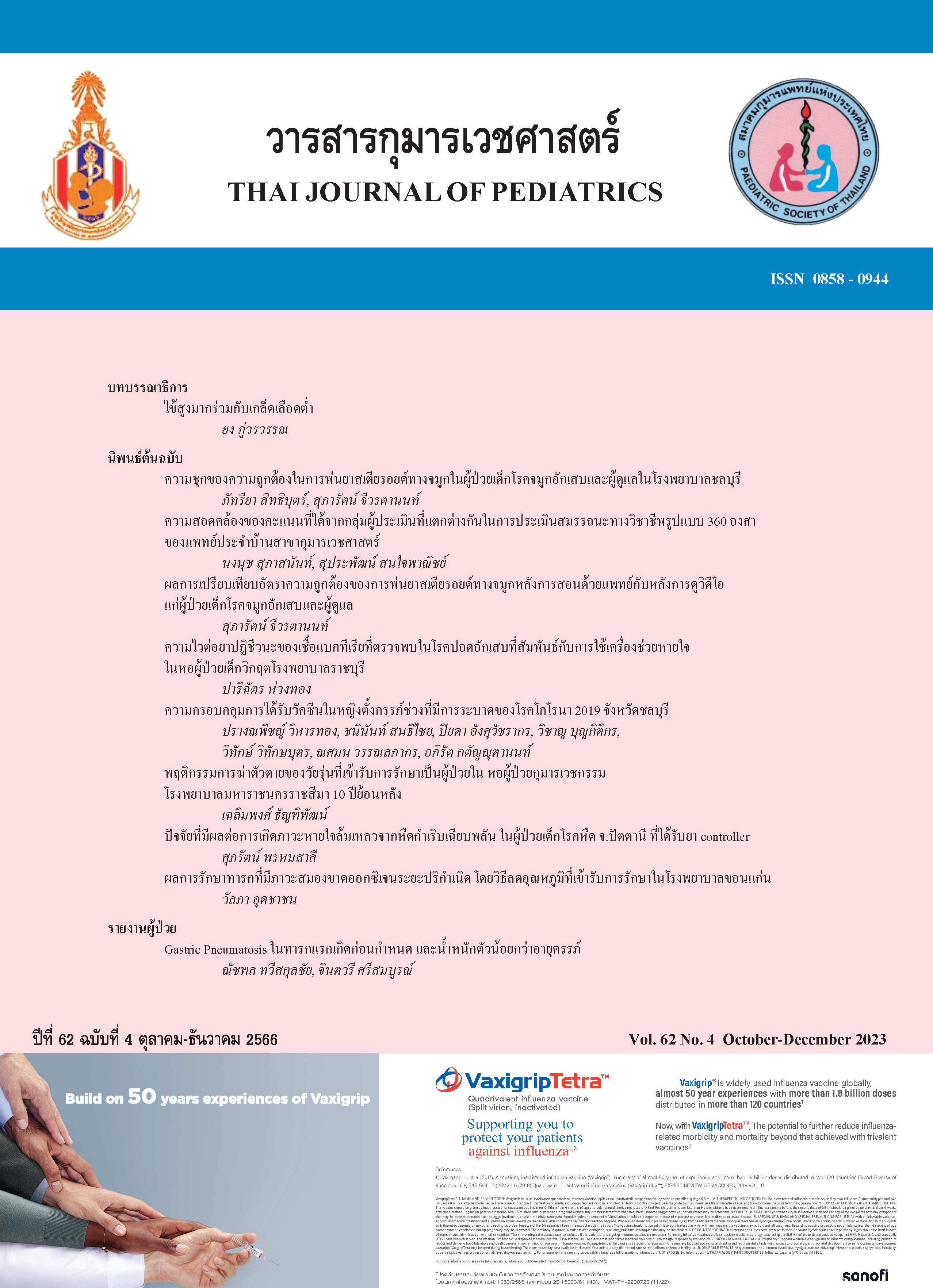ปัจจัยที่มีผลต่อการเกิดภาวะหายใจล้มเหลวจากหืดกำเริบเฉียบพลันในผู้ป่วยเด็กโรคหืด จ.ปัตตานี ที่ได้รับยา controller
คำสำคัญ:
Asthma, asthmatic attack, respiratory failure, controller, weight for age, complianceบทคัดย่อ
ความสำคัญ: โรคทอบหืคเป็นโรคเรื้อรังที่พบมากที่สุดในเด็ก ทำให้คุณภาพชีวิตลดลงหากมีภาวะหืดกำเริบบ่อย ๆ และอาจรุนแรงจนทำให้เกิดภาวะหายใจล้มเหลว และเสียชีวิตได้ ผู้ป่วยจึงจำเป็นต้องได้รับการรักษาโดยการใช้ยาเพื่อควบคุมอาการ และ ลคความรุนแรงของโรค แต่พบว่ายังมีผู้ป่วยส่วนหนึ่งที่ได้รับยาควบคุมอาการแล้ว แต่ยังเกิดภาวะหายใจล้มเหลว
วัตถุประสงค์: เพื่อศึกษาปัจจัยที่ทำให้ผู้ป่วยเด็ก asthma ที่ได้รับยา controller แล้ว ยังเกิดภาวะหายใจ
รูปแบบ สถานที่ และผู้ป่วย: เป็นการศึกษาเชิง prognostic factor research รูปแบบ retrospective case control design ที่กลุ่มงานกุมารเวชกรรม โรงพยาบาลปัตตานี ศึกษาในผู้ป่วยเด็กอายุ 6 เดือน - 15 ปีที่ได้รับการวินิจฉัย asthma และได้รับยา controller ใน จ.ปัตตานี ตั้งแต่ 1 มกราคม 2561 ถึง 31 ธันวาคม 2564
การวัดผล และวิธีการ: ค้นหาข้อมูลผู้ป่วยเด็ก asthma ที่ได้รับ controller และ มีภาวะหายใจล้มเหลวจากใบส่งต่อผู้ป่วยจากโรงพยาบาลชุมชนและเวชระเบียนผู้ป่วย ส่วนข้อมูลผู้ป่วยเด็ก asthma ที่ได้รับ controller แต่ไม่มีภาวะหายใจล้มเหลว ค้นหาจากแฟ้มประจำตัวผู้ป่วยใน asthma clinic รพ.ปัตตานีและ รพ.ชุมชน เปรียบเทียบความสัมพันธ์กับปัจจัยทั้ง 2 กลุ่มด้วย Fisher exact probability test และวิเคราะห์ลักษณะพยากรณ์ด้วย weighted logistic regression for rare event
ผล: ผู้ป่วยเด็ก asthma ที่ได้รับ controller และมีภาวะหายใจล้มเหลว 18 ราย ผู้ป่วยเด็ก asthma ที่ได้รับ controller ในเวลาเดียวกัน แต่ไม่มีภาวะหายใจล้มเหลว 72 ราย เมื่อนำลักษณะที่อาจจะเป็นปัจจัยที่ทำให้เกิดการะหายใจล้มเหลวมาวิเคราะห์ร่วมกัน 11 ปัจจัย ปัจจัยที่ยังคงมีนัยสำคัญทางสถิติ ได้แก่ 1. ภาวะทุพโภชนาการ ประเมินจาก weight for age ที่น้อยกว่า 60% (odds ratio [OR] 128.83, 95% CI 26.89-617.33) 2. การมีโรคอื่นร่วม (ods ratio [OR] 8.44, 95% CI 0.67-106.07) 3. การมีการติดเชื้อทางเดินหายใจร่วมด้วย (odds ratio [OR] 116.01, 95% CI 34.53-389.74) และ 4. การขาดความสม่ำเสมอในการพ่นยาเกิน 1 สัปดาห์ (odds ratio [OR] 245.35, 95% CI 62.95-956.22)
ข้อยุติ และการนำไปใช้: ผู้ป่วยเด็ก asthma ที่ได้รับการรักษาและควบคุมอาการด้วยยา controller แล้ว ยังมีโอกาสเกิดภาวะหืดกำเริบจนทำให้เกิดภาะหายใจล้มเหลวได้ หากผู้ป่วยมีภาวะทุพโภขนาการรุนแรง มีโรคอื่นร่วม มีการติดเชื้อทางเดินหายใจร่วม หรือ ขาดการใช้ยานานเกิน 1 สัปดาห์
Downloads
เอกสารอ้างอิง
Braman SS. The Global Burden of Asthma. Chest. 2006 Jul;130(1):4S-12S.
Vichyanond P, Jirapongsananuruk O, Visitsuntorn N, Tuchinda M. Prevalence of asthma, rhinitis and eczema in children from the Bangkok area using the ISAAC (International Study for Asthma and Allergy in Children) questionnaires. J Med Assoc Thail Chotmaihet Thangphaet. 1998Mar;81(3):175–84.
Prevalence of asthma, level of control and factors associated with asthma control in Thai elementary school students in Bangkok.
AsianPacJAllergyImmunol[Internet].2014[cited2023May23];Availablefrom:http://apjai.digitaljournals.org/index.php/apjai/article/download/1664/1185
Masoli M, Fabian D, Holt S, Beasley R, Program GI for A (GINA). The global burden of asthma: executive summary of the GINA Dissemination Committee Report. Allergy. 2004;59(5):469–78.
Ferrante G, La Grutta S. The Burden of Pediatric Asthma. Front Pediatr. 2018 Jun 22;6:186.
Navanandan N, Hatoun J, Celedón JC, Liu AH. Predicting Severe Asthma Exacerbations in Children: Blueprint for Today and Tomorrow. J Allergy Clin Immunol Pract. 2021 Jul;9(7):2619–26.
Ducharme FM, Tse SM, Chauhan B. Diagnosis, management, and prognosis of preschool wheeze. The Lancet. 2014 May;383(9928):1593–604.
Anderson HR, Pottier AC, Strachan DP. Asthma from birth to age 23: incidence and relation to prior and concurrent atopic disease. Thorax. 1992 Jul;47(7):537–42.
Almqvist C, Worm M, Leynaert B, WP 2.5 ‘Gender’ for the working group of G. Impact of gender on asthma in childhood and adolescence: a GA2LEN review. Allergy. 2008;63(1):47–57.
Borrell LN, Nguyen EA, Roth LA, Oh SS,Tcheurekdjian H, Sen S, et al. Childhood Obesity and Asthma Control in the GALA II and SAGE II Studies. Am J Respir Crit Care Med. 2013 Apr 1;187(7):697–702.
Forno E, Lescher R, Strunk R, Weiss S, Fuhlbrigge A, Celedón JC. Decreased response to inhaled steroids in overweight and obese asthmatic children. J Allergy Clin Immunol. 2011 Mar;127(3):741–9.
Black MH, Zhou H, Takayanagi M, Jacobsen SJ, Koebnick C. Increased Asthma Risk and Asthma-Related Health Care Complications
Associated With Childhood Obesity. Am J Epidemiol. 2013 Oct 1;178(7):1120–8.
Guilbert TW, Bacharier LB, Fitzpatrick AM. Severe asthma in children. J Allergy Clin Immunol Pract. 2014;2(5):489–500.
Blake K, Teague WG. Gastroesophageal reflux disease and childhood asthma: Curr Opin Pulm Med. 2012 Dec;1.
Rust G, Zhang S, Reynolds J. Inhaled corticosteroid adherence and emergency department utilization among Medicaidenrolled children with asthma. J Asthma Off J Assoc Care Asthma. 2013 Sep;50(7):769–75.
Dima AL, Ganse E van, Stadler G, Bruin M de. Does adherence to inhaled corticosteroids predict asthma-related outcomes over time?
A cohort study. Eur Respir J [Internet]. 2019 Dec 1 [cited 2023 Jun 9];54(6). Available from: https://erj.ersjournals.com/content/54/6/1900901
Murphy KR. Adherence to inhaled corticosteroids: Comparison of available therapies. Pulm Pharmacol Ther. 2010 Oct;23(5):384–8.
Axelsson I, Naumburg E, Prietsch SO, Zhang L. Inhaled corticosteroids in children with persistent asthma: effects of different drugs and delivery devices on growth. Cochrane Database Syst Rev. 2019 Jun 10;2019(6):CD010126.
Baptist AP, Reddy RC. Inhaled corticosteroids for asthma: are they all the same? J Clin Pharm Ther. 2009;34(1):1–12.
McCarville M, Sohn MW, Oh E, Weiss K, Gupta R. Environmental tobacco smoke and asthma exacerbations and severity: the difference between measured and reported exposure. Arch Dis Child. 2013 Jul 1;98(7):510–4.
Saraya T, Kurai D, Ishii H, et al. Epidemiology of virus-induced asthma exacerbations: with special reference to the role of human rhinovirus. Front Microbiol. 2014 May 26;5:226.
Stein RT, Sherrill D, Morgan WJ, et al. Respiratory syncytial virus in early life and risk of wheeze and allergy by age 13 years. The Lancet. 1999 Aug;354(9178):541–5.
Duenas Meza E, Jaramillo CA, Correa E, et al. Virus and Mycoplasma pneumoniae prevalence in a selected pediatric population with acute asthma exacerbation. J Asthma. 2016 Mar 15;53(3):253–60.
ดาวน์โหลด
เผยแพร่แล้ว
รูปแบบการอ้างอิง
ฉบับ
ประเภทบทความ
สัญญาอนุญาต

อนุญาตภายใต้เงื่อนไข Creative Commons Attribution-NonCommercial-NoDerivatives 4.0 International License.



